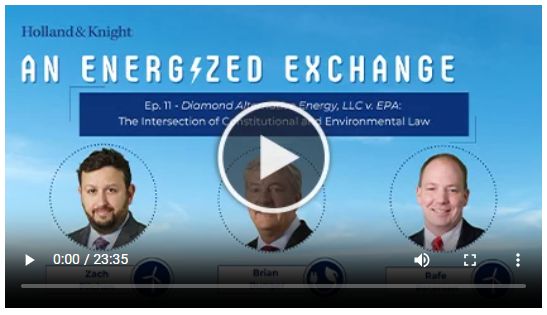In this episode of our "An Energized Exchange" podcast series, presented by the Energy & Natural Resources Industry Sector Group, attorneys Zach Pilchen, Brian Bunger and Rafe Petersen discuss the U.S. Supreme Court's decision in Diamond Alternative Energy, LLC v. The Environmental Protection Agency (EPA) and its constitutional, environmental and judicial implications. The case stems from California's unique authority under the Clean Air Act to enforce vehicle emission standards, requiring automakers to manufacture more electric vehicles and fewer liquid fuel-powered vehicles. Though these standards directly regulate automakers, the case was made by fuel companies that their business would be impacted by the decrease in demand for gasoline and diesel. The conversation also touches on the impact of the Supreme Court's decision regarding ongoing battles over California's air quality rules and other EPA regulations, suggesting more legal challenges may arise from a wider range of players on the various sides of environmental issues.
Podcast Transcript
Zach Pilchen: Welcome to another episode of "Energized Exchange," a Holland & Knight podcast. I'm Zach Pilchen, senior counsel in our Washington, D.C., office, and today we're diving into the recent Supreme Court decision in Diamond Alternative Energy v. The Environmental Protection Agency (EPA). This case has some interesting implications about Article III standing, particularly for companies that aren't directly regulated by government action, but nevertheless are affected by it, and also some practical implications for California's unique authority under the Clean Air Act. Joining me today are Brian Bunger, partner in our San Francisco office, and Rafe Petersen, partner in our Washington, D.C., office. Both of whom are in environmental law and are going to help us unpack this complex case. Brian, why don't we start with you? Can you give us a little background on what the California waiver is and what the context of this case arises in?
Brian Bunger: Sure, Zach. Good to be with you guys today, chatting through this case. This case that we'll talk about is a bit about Article III standing under the Constitution and how parties have access to the federal courts. But the background for the case is related to the California waiver, which people have been talking about for a variety of reasons recently. And the California waiver is a provision in the Clean Air Act that allows, uniquely California, to regulate motor vehicle emissions. For most states, the Clean Air Act preempts any sort of state action on motor vehicle admissions, but because when the Clean Air Act was originally written all the way back in 1967, California already had a fairly robust vehicle emission program in place. So the Clean Air Act carves out a waiver provision for California to regulate in this space. As long as California can show that it needs the regulations to meet its unique air quality problems, then EPA is not just authorized, but really mandated to grant a waiver to California for those provisions. Once California has adopted and had the waiver granted to it, then other states can follow suit — that's under Section 209(b) of the Clean Air Act. The particular waiver at issue here relates to California's Advanced Clean Cars program, which was put in place many, many years ago now and has gone through a twisted path, which I think Zach is going to outline a bit for us. But in any event, what it did is mandated a certain level of greenhouse gas control on motor vehicle emissions, and so several challenges were mounted to that and this case arises out of those challenges.
Zach Pilchen: Thanks, Brian. As you indicate, the waiver at issue in Diamond Alternative Energy does have a bit of a ping-ponging history. The Obama Administration had initially granted California a waiver for that program that included the greenhouse gas standards, but then EPA under the first Trump Administration partially withdrew that waiver in 2019. There were a lot of questions about whether the withdrawal of that waiver was lawful and litigation that ultimately didn't go anywhere because, under the Biden Administration in 2022, EPA reinstated that waiver. So, fuel producers and several states challenged that 2022 reinstatement, giving rise to the instant case. And Brian, if you could tell us a little bit about Ohio v. EPA challenging that rule in the lower court, that would be very helpful.
Brian Bunger: Thanks, Zach. So in Ohio v. EPA, which is the D.C. Circuit case at issue, there were a number of petitioners. Chief among them were a set of private party petitioners that challenged the waiver on the ground that it improperly made it more difficult for them to sell liquid fuels into the market because the mix of vehicles would change such that there would be more electric vehicles mandated over the course of time. And then there was a set of state petitioners as well, which challenged the waiver on constitutional grounds. So the state petitioners articulated a claim that under the equal sovereigns doctrine that had been set forth by the Supreme Court, allowing one state to regulate in this space would abrogate their rights as states to regulate the way they saw fit. And so the D.C. Circuit decision that underlies Diamond Alternative Energy actually decided that the states had standing to assert that claim and then found no merit in the claim. But on the private party side, the D.C. Circuit decision was that the parties did not have standing, and that was essentially based on the fact that they are not directly regulated by the underlying rule for which the waiver was granted. So the underlying rule directly regulates only the motor vehicle manufacturers who produce the vehicles that are subject to it. But the fuel producers, of course, are impacted by that. But the D.C. Circuit's view was that they hadn't sufficiently demonstrated that if they set aside the waiver, that the fuel producers' economic injuries would be redressed. Before we get into more details on the decisions, Rafe, could you give us an overview of the standing doctrines?
Rafe Petersen: So that leads really to the question of what is standing, and what standing is, in essence, it's the right to sue. While many entities may be upset about how they're regulated or the effects of regulation, it doesn't necessarily mean they get into courts. And Article III of the Constitution limits federal court jurisdiction to cases or controversies. And what that requires then is a prospective plaintiff to demonstrate standing by showing three elements: they have to show injury in fact, causation and redressability. And many courts in the D.C. Circuit in particular, where a lot of federal litigation takes place, particularly litigation regarding Clean Air Act and over federal action, requires it to be shown at the earliest possible time. And they also require it for interveners. So unlike other circuits, to intervene in an existing case, you first have to also, again, prove injury in fact, causation and redressability. So what is injury? Injury requires a concrete, particularized injury that's actual or imminent. So essentially a party wishing to sue has to show that they have some sort of — sometimes it'll be a legal right that is going to get affected, other times they're going to say that the injury is going be to something that they, maybe it's like an economic injury — but they have to prove that this injury is concrete and particularize it happens to them. To show causation they actually have to show that the injury is caused by the defendant. So not necessarily a third party — we'll get into that — but by the defendant, by the underlying action that they're challenging. And finally, redressability requires demonstrating that judicial relief would redress their injury. You have to show that, hey, if I won this case, the court would do something that would alleviate the concrete and particularized injury to me. The focus is on the relief the court can grant. So the tricky one, and that's how this case kind of evolved, is when a plaintiff is not the direct object of the government regulation. Causation and redressability often depend on how third parties, not before the court, will respond to the regulations of judicial relief. So as Brian mentioned, California intervened in this case, and they immediately challenged the standing of the fuel producers. And to establish the standing the fuel producers produced 14 declarations and devoted a couple pages of their briefs to standing, and they argued that the demand for gasoline and diesel fuel will be depressed by California's regulations because they require the sale of vehicles that use less gasoline and diesel fuel, or use no diesel fuel or liquid fuel at all. The D.C. court explained that the redressability depends on how third-party automakers would act in the absence of these fleet-wide emission standards. They said the fuel producers failed to cite any record evidence or file any additional affidavits demonstrating that automakers will respond in the way in which they said they would. So that's how we got up to the Supreme Court.
Brian Bunger: Yeah, which brings us to the decision in Diamond Alternative Energy. So, in a 7-2 opinion authored by Justice Brett Kavanaugh, the Supreme Court reversed the D.C. Circuit ruling on redressability and held that petitioners had, quote, "readily established standing," end quote, by reference to, quote, "common-sense economic principles," end quote. So specifically, the court found that the California rules forced automakers to produce a fleet of vehicles that would use significantly less gasoline and other liquid fuels. In fact, that was the point of the regulations. And accordingly, the court held that the rule would cause quote, "predictable injuries," and I think we're going to see over time how these concepts develop. But those injuries on the fuel producers could be fairly expected based on eliminating this liquid fuel vehicle fleet or limiting the amount of liquid fuel vehicles that would be sold, and therefore a ruling striking the waiver would redress those injuries. The court pointed to a number of pieces of record evidence to substantiate that analysis, including declarations that prior California rules had substantially harmed fuel producers, statements from EPA in California that the rule would likely decrease fuel use and affidavits from automakers who intervened in support of the rule, on the grounds that it ensured a level playing field, presumably because otherwise, competitors would produce fewer electric vehicles. The Supreme Court also emphasized that the fuel producers did not have to produce expert economic evidence on market behavior if, as was the case here, they can simply show a predictable chain of events between judicial relief and redress of their injuries. So one of the interesting aspects of this case is that ordinarily standing cases seem to be narrowing availability of federal courts, and this decision feels a bit like it's expanding it slightly. And I'm curious, Zach and Rafe, how you perceive that.
Zach Pilchen: Yeah, I mean, on injury, it's kind of been a long-established thing. There are all types of injuries that people can experience that are cognizable. Some of them are very concrete — you're literally physically injured by something — or in economic terms — as the opinion says, $1 of harm is an injury. And there are others that are more abstract: things that you take in response to risks or aesthetic injuries, things that just kind of cause you to potentially voluntarily change your behavior. Now, those often come up in environmental cases, but even though those can be quite complicated and seem to be somewhat falling out of favor, I would say, it's just interesting that $1 is enough to get into court. And that certainly makes the causation and redressability argument a little easier if you can show that you will be $1 better off if the case goes your way. And that really does, I think, make this a much different playing field for companies alleging economic harms than it does for individuals alleging environmental harms, for example.
Rafe Petersen: And like you were saying, it cuts against, a little bit, some of the court's more recent jurisprudence on standing. And it may be because they're sort of expanding almost, we'll call it economic standing, but for a circuit like the D.C. Circuit, I think this has pretty big implications because that's often the centerpiece of where a lot of federal litigation takes place. And I think by expanding the number of parties who can get into the courts, in a court that in a lot ways is at least close to overwhelmed, it's going to be interesting what this does simply to their docket. And we have an interesting period of time where we have differences, really big differences, of opinions depending on who's currently running the executive branch. And you have this really big swing, almost 180 degrees, of different interpretations of our statutes, and now you're introducing into this, expanding the number of types of parties who can sue. I'm wondering if it's going to be a little overwhelming for the courts to have to deal with the pure volume of litigation. The D.C. Circuit has always . . . they really police their docket pretty tightly and, you know, the joke is that you round up the usual suspects before you get to sue in the D.C. Circuit. You're usually challenged by standing, ripeness, mootness and all these other jurisdictional hurdles. And this takes away one pretty big jurisdictional hurdle for some parties, and it's going to be interesting. Especially now where it appears we're going to get a lot more litigation challenging the current administration — is this going to result in a floodgate of litigation? It's possible because this can be used by parties who both favor and then don't favor what the current administration is doing. So stay tuned, it's going to be interesting to see how this plays out.
Zach Pilchen: Yeah, I mean, one thing I was wondering on that point, Rafe and Brian, I don't know if you have any thoughts on this, is, on the other hand, this seems like a kind of unusual circumstance where this is a rule that is most plainly directly regulating automakers. Although I think the court in the majority opinion leaves open that perhaps the fuel producers might be, kind of an object of the regulation, even if they're not directly regulated. But I mean, how often do you have a situation like this, where there's a rule that's very heavily controversial and it's challenged by people who are not actually the directly regulated entities? I mean if automakers had been — any single automaker — had been in this case, it feels like the outcome might have been much different.
Brian Bunger: Well, it certainly would have felt more obvious, because that would have been the directly regulated party and, at least in theory, the idea would have been that redressability and injury and that sort of thing were fairly obvious. But this case feels a little bit odd in the long history of jurisprudence, right. I think we've all understood over time that the federal courts are courts of limited jurisdiction. And one of the ways that's always been managed is through the standing doctrines. And in this particular instance, it feels like there's a bit of an expansion, at least in this economic injury domain. Now I wonder whether it will apply as evenly across other plaintiff classes. So for example, if there is some change in how Medicaid or Medicare is administrated, the people who receive it are not the recipients of the regulation, they might ultimately be the target in the same sense that the fuel producers were, but those regulations really apply to the providers. Would they then have standing to challenge those changes? I wonder. That's sort of the type of situation I'm thinking of where there's a third party who's directly impacted, but not directly regulated. I wonder where that goes.
Rafe Petersen: Yeah. And does that expand beyond non-economic harm? Will the court extend this approach to non-economic injuries as well, or is this just unique to economic injuries? And depending on that, that would be, to me, a pretty big sea change in terms of how this court has been looking at standing. And so yeah, this may be a one-off or this may be the beginning of a trend. We'll have to see how the circuits run with it. You know, now you have, for example, the D.C. Circuit and the Ninth Circuit who have different views of the extent of standing, and how those two circuits are going to run with it would be very interesting.
Zach Pilchen: Well, that leads into the dissents and, you know, the dissents are the dissents. There's a dissent from Justice Sotomayor and also a dissent from Justice Jackson. And the Justice Jackson dissent, at least, gets into some of that concept, Rafe, in terms of is this a rule that is just for economic injury and highlighting a number of cases from the Supreme Court's standing precedents that seem to have pretty significant, what we would call colloquially, harms, injuries, but that have not been, where causation and redressability have not been treated as generously perhaps as the economic harms here. Also, I'll just note that Justice Sotomayor has a dissent that's very short and just points out that the D.C. Circuit made an error in its decision, an error that EPA admits at the Supreme Court level, which is that they thought that these California standards would not persist beyond 2025. And she suggests that there should have just been a remand to the D.C. Circuit because that misconception was a critical part of the D.C. Circuit's opinion saying how can you predict what an automaker would do? We're almost at the end of this program and 2025, time has basically run out, when in fact that was a mistake. But I don't know if either of you had any thoughts about the dissents.
Brian Bunger: Well, I agree with you that Justice Jackson's dissent gets into the issues we were just talking about in terms of where does this doctrine end or where does it go from here. Is it really just about business litigants and economic injuries, or is it about any litigant with economic or perhaps other injuries, third-party standing issues? It's an interesting dissent, I think it opens the door to more questions than answers, obviously. The Sotomayor dissent is also interesting in that the view there was, look, we should be careful when we grant certiorari, and this case just didn't warrant it. We had a mistake at the circuit level and we should simply have returned it to them to deal with that first. So, it looks like the court taking a case that at least some of the members of the court didn't feel was necessary to take, and one wonders what that represents for the future as well.
Zach Pilchen: Well, looking forward, there are going to be implications from this case as precedent, but also there are really direct implications from this case for the future of the underlying litigation and California's waiver, which has experienced some unprecedented congressional attention recently, the Trump Administration saying that they are going to reconsider the reinstatement of the withdrawn original waiver, if that's not too many double negatives for you. Any thoughts on what this means for the next steps in Ohio v. EPA in the immediate term and beyond?
Brian Bunger: Yeah, that's a great question, Zach. So as I mentioned earlier on in Ohio v. EPA, the D.C. Circuit said that the states had standing and then went on to actually address the merits of their arguments and found against them, and the states sought review, but that was not granted. So that piece, I believe, is at least law of the case, if not law of the circuit now. The private party claims have not actually been litigated on the merits yet because of the standing decision. So the case went back to the circuit last week, end of last week, and we'll have to see what additional proceedings happen there. There's actually two other cases pending in the D.C. Circuit that are somewhat related. So, in addition to the Advanced Clean Cars program, EPA itself had adopted a set of greenhouse gas emission standards. And those were challenged in a case that styled Texas v. EPA, which is D.C. Circuit case number 22-1031. And then a follow-on California regulation called the Advanced Clean Cars II regulation, which took the Advanced Clean Cars regulation a step further, has also been challenged. There's also a challenge to the Advanced Clean Trucks regulation, which was the application of similar standards to heavy- and medium-duty trucks. And that latter case and the EPA case are both currently being held in abeyance in the D.C. Circuit pending the outcome of Ohio v. EPA. And when originally the D.C. Circuit opinion came down in Ohio, in Texas v. EPA, the court ordered additional briefing on the standing question, and that briefing was filed. Subsequently, cert (certiorari) was granted for Diamond Alternative Energy. And so the question now is, what does the court do with the merits of those claims being brought by the fuel producers and others? So we'll have to see how that plays out. But the story is not yet done in the D.C. Circuit with those pending cases. And of course, there's the additional complexity, which you mentioned, which is that Congress has acted to revoke the waivers under the Congressional Review Act, and that is itself subject to litigation. So there is a number of parts in motion right now. We'll have to see how this all fits together in the end.
Zach Pilchen: Well, this has been a fascinating discussion about a case that touches on these constitutional issues, environmental legal issues and judicial access. And I just want to thank you, Brian and Rafe, for joining me today and talking through it. And we'll just have to keep watching this space as things further develop.
Brian Bunger: Thanks, Zach. It was a pleasure to be here.
The content of this article is intended to provide a general guide to the subject matter. Specialist advice should be sought about your specific circumstances.




